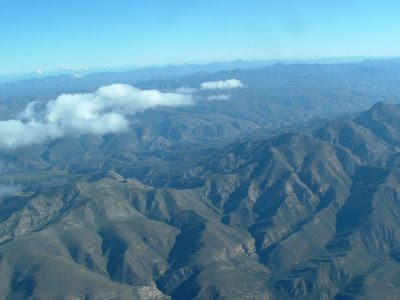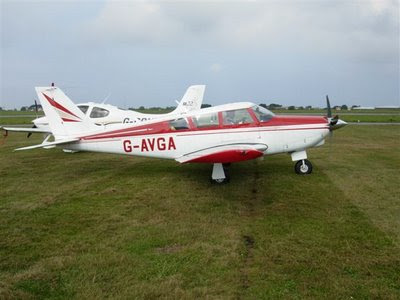





Before launching into these Radio Practice Routes here is a reminder of the recent amendment to CAP413 the UK Safety Regulation Group (CAA) Radiotelephony Manual (Click here for the link to CAP413):
 If YOU want to be PROFESSIONAL then conform to this amendment (above).
If YOU want to be PROFESSIONAL then conform to this amendment (above).All six figures shall be used when identifying frequencies irrespective of whether they are 25kHz or 8.33 kHz spaced. Exceptionally, when the final two digits are both zero, only the first four digits need be given
Here are some examples:
- 118.350
- 134.175
- 122.125
- 130.550
- 124.075
- 121.5
- 120.9
- 118.050
- 125.2
Be Professional. When using an abbreviated callsign permitted by ATC's response to your initial call of e.g. "G-DACF" the correct response is "G-CF". It is never acceptable to use just "CF". Always, always start with the National Registration Letter , Letters or Number: "G", "F", "EI", "OO","N", "R", "ZS", "A2" etc. "Golf Charlie Foxtrot" NOT "Charlie Foxtrot". (Editor's note: Sorry, the words "Grandmother", "Suck", "Eggs" and "Teach" are coming into mind!)
Here are some Practice Radio Exercises:
Note: An Aerodrome Air/Ground Station can only offer an Aerodrome/Ground Communication Service (AGCS). For ATC and FIS see CAP413.
CIRCUITS:
Aircraft: XXXX Radio Golf Oscar Delta Alpha Charlie (GOLF OSS CAH DELL TAH AL FAH CHAR LEE) request radio check on 118.350 (WUN WUN AIT DAYSEEMAL TREE FIFE ZERO) and information.
Ground: Golf Alpha Charlie XXXX reading you strength five. Runway for departure 17 left hand. QFE 1010. QNH 1016.
Aircraft: Runway 17 left hand. QFE 1010. QNH 1016. Golf Alpha Charlie.
Aircraft: G-AC crossing runway 05.
Ground: G-AC roger. No known traffic to affect. Be advised, one aircraft on short final.
Aircraft: G-AC ready for departure.
Ground: G-AC roger. Surface wind 080˚ 6 knots.
Aircraft: G-AC downwind (05 to land/low approach and go-around/glide approach/flapless approach).
Ground: G-AC roger. Advise final.
Aircraft: Advise final G-AC.
Aircraft: G-AC final.
Ground: G-AC roger. Surface wind 080˚ 6 knots.
Aircraft: G-AC going around.
Ground: G-AC roger, advise downwind.
TRAINING FLIGHT:
Aircraft: G-AC overhead Church Broughton. Departing the circuit to the west. Remaining on frequency/changing to East Midlands 134.175.
Ground: G-AC roger. Advise on rejoin.
Aircraft: Advise on rejoin G-AC.
Aircraft: G-AC approaching Church Broughton from the west for rejoin.
Ground: G-AC roger. Runway for landing 05LH. QFE 1010.
Aircraft: Runway 05LH. QFE 1010. G-AC.
Ground: G-AC roger. Advise downwind.
Aircraft: Advise downwind G-AC.
NEWPORT LAKE/STOKE SERVICES:
Aircraft: G-AC overhead Church Broughton departing the circuit to the west changing to East midlands 134.175.
Ground: G-AC roger. Advise on rejoin.
Aircraft: Wilco G-AC.
Aircraft: East Midlands Approach G-ODAC for Flight Information Service.
Ground: G-AC pass your message/G-AC standby.
Aircraft: G-AC Cessna 152 XXXX to XXXX on a (solo) navex turning overhead Newport Lake and Stoke Services. Currently overhead Church Broughton 2,400 feet. Request flight information service.
Ground: G-AC roger. Flight information service you have. QNH 1016. Report changing frequency.
Aircraft: Flight information service. QNH 1016. Wilco G-AC.
Aircraft: G-AC overhead Hixon disused airfield. Request frequency change to Shawbury 120.775.
Ground: G-AC roger frequency change approved.
Aircraft: G-AC
Aircraft: Shawbury Radar G-ODAC for flight information service.
Ground: G-AC pass you details.
Aircraft: G-AC Cessna 152 XXXX to XXXX on a (solo) navex turning overhad Newport Lake and Stoke Services. Currently overhead Hixon 2,400 feet. request flight information service.
Ground: G-AC roger. Flight information service. Barnsley 1012. Report turning at Newport Lake.
Aircraft: Flight information service. barnsley 1012. Wilco G-AC.
Ground: G-AC roger. For conspicuity squawk 0240.
Aircraft: Squawk 0240 G-AC.
Aircraft: G-AC turning overhead Newport Lake. setting course for Stoke Services on the M6.
Ground: G-AC roger. Report changing frquency.
Aircraft: Wilco G-AC.
Aircraft: G-AC turning overhead Stoke Services. request frequency change to East Midlands 134.175.
Ground: G-AC roger. Squawk 7000. free call East Midlands 134.175.
Aircraft: Squawk 7000. Free call East Midlands G-AC.
Aircraft: East Midlands Approach G-ODAC for flight information service.
Ground: G-AC East Midlands pass your message.
Aircraft: G-AC C152 XXXX to XXXX on a (solo) navex turning overhead Newport Lake and Stoke Services. Currently overhead Stoke services 2,400 feet. Request flight information service.
Ground: G-AC roger. Flight information service. East Midlands QNH 1016.
Aircraft: Flight information service. QNH 1016. G-AC.
Aircraft: G-AC 3 miles west of Church Broughton. Request frequency change to XXXX on 118.350.
Ground: G-AC roger frequency change approved.
Aircraft: G-AC.
(To be continued)
Meanwhile, here are some pages extracted from CAP413:
Aircraft: XXXX Radio Golf Oscar Delta Alpha Charlie (GOLF OSS CAH DELL TAH AL FAH CHAR LEE) request radio check on 118.350 (WUN WUN AIT DAYSEEMAL TREE FIFE ZERO) and information.
Ground: Golf Alpha Charlie XXXX reading you strength five. Runway for departure 17 left hand. QFE 1010. QNH 1016.
Aircraft: Runway 17 left hand. QFE 1010. QNH 1016. Golf Alpha Charlie.
Aircraft: G-AC crossing runway 05.
Ground: G-AC roger. No known traffic to affect. Be advised, one aircraft on short final.
Aircraft: G-AC ready for departure.
Ground: G-AC roger. Surface wind 080˚ 6 knots.
Aircraft: G-AC downwind (05 to land/low approach and go-around/glide approach/flapless approach).
Ground: G-AC roger. Advise final.
Aircraft: Advise final G-AC.
Aircraft: G-AC final.
Ground: G-AC roger. Surface wind 080˚ 6 knots.
Aircraft: G-AC going around.
Ground: G-AC roger, advise downwind.
TRAINING FLIGHT:
Aircraft: G-AC overhead Church Broughton. Departing the circuit to the west. Remaining on frequency/changing to East Midlands 134.175.
Ground: G-AC roger. Advise on rejoin.
Aircraft: Advise on rejoin G-AC.
Aircraft: G-AC approaching Church Broughton from the west for rejoin.
Ground: G-AC roger. Runway for landing 05LH. QFE 1010.
Aircraft: Runway 05LH. QFE 1010. G-AC.
Ground: G-AC roger. Advise downwind.
Aircraft: Advise downwind G-AC.
NEWPORT LAKE/STOKE SERVICES:
Aircraft: G-AC overhead Church Broughton departing the circuit to the west changing to East midlands 134.175.
Ground: G-AC roger. Advise on rejoin.
Aircraft: Wilco G-AC.
Aircraft: East Midlands Approach G-ODAC for Flight Information Service.
Ground: G-AC pass your message/G-AC standby.
Aircraft: G-AC Cessna 152 XXXX to XXXX on a (solo) navex turning overhead Newport Lake and Stoke Services. Currently overhead Church Broughton 2,400 feet. Request flight information service.
Ground: G-AC roger. Flight information service you have. QNH 1016. Report changing frequency.
Aircraft: Flight information service. QNH 1016. Wilco G-AC.
Aircraft: G-AC overhead Hixon disused airfield. Request frequency change to Shawbury 120.775.
Ground: G-AC roger frequency change approved.
Aircraft: G-AC
Aircraft: Shawbury Radar G-ODAC for flight information service.
Ground: G-AC pass you details.
Aircraft: G-AC Cessna 152 XXXX to XXXX on a (solo) navex turning overhad Newport Lake and Stoke Services. Currently overhead Hixon 2,400 feet. request flight information service.
Ground: G-AC roger. Flight information service. Barnsley 1012. Report turning at Newport Lake.
Aircraft: Flight information service. barnsley 1012. Wilco G-AC.
Ground: G-AC roger. For conspicuity squawk 0240.
Aircraft: Squawk 0240 G-AC.
Aircraft: G-AC turning overhead Newport Lake. setting course for Stoke Services on the M6.
Ground: G-AC roger. Report changing frquency.
Aircraft: Wilco G-AC.
Aircraft: G-AC turning overhead Stoke Services. request frequency change to East Midlands 134.175.
Ground: G-AC roger. Squawk 7000. free call East Midlands 134.175.
Aircraft: Squawk 7000. Free call East Midlands G-AC.
Aircraft: East Midlands Approach G-ODAC for flight information service.
Ground: G-AC East Midlands pass your message.
Aircraft: G-AC C152 XXXX to XXXX on a (solo) navex turning overhead Newport Lake and Stoke Services. Currently overhead Stoke services 2,400 feet. Request flight information service.
Ground: G-AC roger. Flight information service. East Midlands QNH 1016.
Aircraft: Flight information service. QNH 1016. G-AC.
Aircraft: G-AC 3 miles west of Church Broughton. Request frequency change to XXXX on 118.350.
Ground: G-AC roger frequency change approved.
Aircraft: G-AC.
(To be continued)
Meanwhile, here are some pages extracted from CAP413:







Work-in-progress. More to come. Watch this space.....................................


















 You will notice that ahead - just after Banbury town - is the OXFORD AIAA (Area of Intense Aerial Activity - see picture above). Thinking ahead it is therefore necessary to leave Coventry Approach and call BRIZE ZONE on 124.275 for a Flight Information Service OR Radar Information Service.
You will notice that ahead - just after Banbury town - is the OXFORD AIAA (Area of Intense Aerial Activity - see picture above). Thinking ahead it is therefore necessary to leave Coventry Approach and call BRIZE ZONE on 124.275 for a Flight Information Service OR Radar Information Service. 


 The Banbury to Oxford railway line more or less leads us into Oxford Kidlington. We should, by now, have been released by Brize Zone and be in contact with Oxford Approach on 125.325.
The Banbury to Oxford railway line more or less leads us into Oxford Kidlington. We should, by now, have been released by Brize Zone and be in contact with Oxford Approach on 125.325. 












